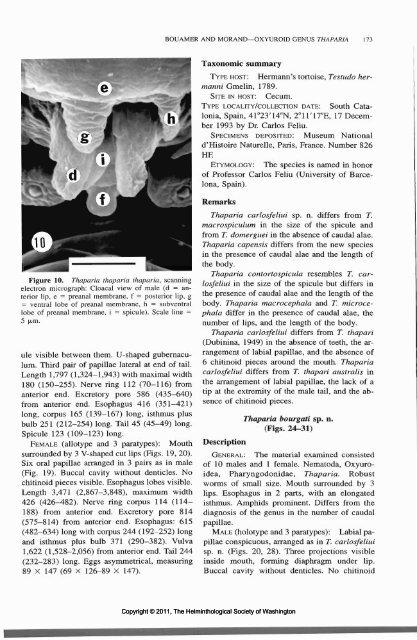Comparative Parasitology 67(2) 2000 - Peru State College
Comparative Parasitology 67(2) 2000 - Peru State College
Comparative Parasitology 67(2) 2000 - Peru State College
You also want an ePaper? Increase the reach of your titles
YUMPU automatically turns print PDFs into web optimized ePapers that Google loves.
Figure 10. Thaparia thaparia thaparia, scanning<br />
electron micrograph: Cloacal view of male (d = anterior<br />
lip, e = preanal membrane, f = posterior lip, g<br />
= ventral lobe of preanal membrane, h = subventral<br />
lobe of preanal membrane, i = spicule). Scale line =<br />
5 (xm.<br />
ule visible between them. U-shaped gubernaculum.<br />
Third pair of papillae lateral at end of tail.<br />
Length 1,797 (1,324-1,943) with maximal width<br />
180 (150-255). Nerve ring 112 (70-116) from<br />
anterior end. Excretory pore 586 (435-640)<br />
from anterior end. Esophagus 416 (351-421)<br />
long, corpus 165 (139-1<strong>67</strong>) long, isthmus plus<br />
bulb 251 (212-254) long. Tail 45 (45-49) long.<br />
Spicule 123 (109-123) long.<br />
FEMALE (allotype and 3 paratypes): Mouth<br />
surrounded by 3 V-shaped cut lips (Figs. 19, 20).<br />
Six oral papillae arranged in 3 pairs as in male<br />
(Fig. 19). Buccal cavity without denticles. No<br />
chitinoid pieces visible. Esophagus lobes visible.<br />
Length 3,471 (2,8<strong>67</strong>-3,848), maximum width<br />
426 (426-482). Nerve ring corpus 114 (114-<br />
188) from anterior end. Excretory pore 814<br />
(575-814) from anterior end. Esophagus: 615<br />
(482-634) long with corpus 244 (192-252) long<br />
and isthmus plus bulb 371 (290-382). Vulva<br />
1,622 (1,528-2,056) from anterior end. Tail 244<br />
(232-283) long. Eggs asymmetrical, measuring<br />
89 X 147 (69 X 126-89 X 147).<br />
BOUAMER AND MORAND—OXYUROID GENUS THAPARIA 173<br />
Taxonomic summary<br />
TYPE HOST: Hermann's tortoise, Testudo hermanni<br />
Gmelin, 1789.<br />
SITE IN HOST: Cecum.<br />
TYPE LOCALITY/COLLECTION DATE: South Catalonia,<br />
Spain, 41°23'14"N, 2°11'17"E, 17 December<br />
1993 by Dr. Carlos Feliu.<br />
SPECIMENS DEPOSITED: Museum National<br />
d'Histoire Naturelle, Paris, France. Number 826<br />
HE<br />
ETYMOLOGY: The species is named in honor<br />
of Professor Carlos Feliu (University of Barcelona,<br />
Spain).<br />
Remarks<br />
Thaparia carlosfeliui sp. n. differs from T.<br />
macrospiculum in the size of the spicule and<br />
from T. domerguei in the absence of caudal alae.<br />
Thaparia capensis differs from the new species<br />
in the presence of caudal alae and the length of<br />
the body.<br />
Thaparia contortospicula resembles T. carlosfeliui<br />
in the size of the spicule but differs in<br />
the presence of caudal alae and the length of the<br />
body. Thaparia macrocephala and T. microcephala<br />
differ in the presence of caudal alae, the<br />
number of lips, and the length of the body.<br />
Thaparia carlosfeliui differs from T. thapari<br />
(Dubinina, 1949) in the absence of teeth, the arrangement<br />
of labial papillae, and the absence of<br />
6 chitinoid pieces around the mouth. Thaparia<br />
carlosfeliui differs from T. thapari australis in<br />
the arrangement of labial papillae, the lack of a<br />
tip at the extremity of the male tail, and the absence<br />
of chitinoid pieces.<br />
Thaparia bourgati sp. n.<br />
(Figs. 24-31)<br />
Description<br />
GENERAL: The material examined consisted<br />
of 10 males and 1 female. Nematoda, Oxyuroidea,<br />
Pharyngodonidae, Thaparia. Robust<br />
worms of small size. Mouth surrounded by 3<br />
lips. Esophagus in 2 parts, with an elongated<br />
isthmus. Amphids prominent. Differs from the<br />
diagnosis of the genus in the number of caudal<br />
papillae.<br />
MALE (holotype and 3 paratypes): Labial papillae<br />
conspicuous, arranged as in T. carlosfeliui<br />
sp. n. (Figs. 20, 28). Three projections visible<br />
inside mouth, forming diaphragm under lip.<br />
Buccal cavity without denticles. No chitinoid<br />
Copyright © 2011, The Helminthological Society of Washington

















